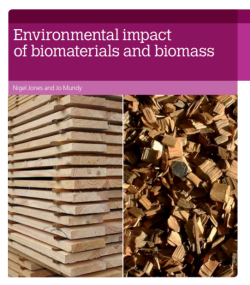Environmental impact of biomaterials and biomass (FB 67)
BRE (Building Research Establishment) is an independent, research-based consultancy, testing and training organisation, operating in the built environment and associated industries.
Environmental impact of biomaterials and biomass (FB 67) was written by Nigel Jones and Jo Mundy and published by BRE on 27 May 2014. It is part of a series that provides comparable information on windows, masonry and concrete, metals, floor finishes, cladding and insulation to assess the environmental impact of specific construction materials.
This 24-page report reviews how biomaterials and biomass have been assessed within The Green Guide to Specification (4th edition), including the application of the environmental profiles methodology. The way in which biomaterials and biomass are addressed within building-level environmental assessment schemes such as BREEAM and the Code for Sustainable Homes is also explained.
Within The Green Guide, biomaterials are classed as naturally-derived construction materials (ie those originating from plant or animal sources) providing both structural and non-structural functions within the building fabric. Biomass is a biological material used as a fuel.
The report gives manufacturers and specifiers a general understanding of the benefits and impacts of biomaterials and biomass over their life cycle and helps identify opportunities for improvements in their environmental performance.
It’s contents are:
- Glossary
- Introduction
- Sector overview
- Life cycle assessment, Environmental Profiles and The Green Guide
- Applying the updated Environmental Profiles methodology to biomaterials and biomass
- Key impacts and opportunities for the biomaterials and biomass sector
- Where more data are required
- Conclusions
- References
[edit] Related articles on Designing Buildings Wiki
- Biogas.
- Biomass.
- Biomaterial.
- BRE articles on Designing Buildings Wiki.
- BRE Buzz articles on Designing Buildings Wiki.
- BREEAM.
- Building Research Establishment.
- Code for sustainable homes.
- Environmental impact.
- Life cycle inventory.
- Sustainable materials.
- Timber.
- Types of fuel.
- Wood pellet mill basics.
Featured articles and news
RTPI leader to become new CIOB Chief Executive Officer
Dr Victoria Hills MRTPI, FICE to take over after Caroline Gumble’s departure.
Social and affordable housing, a long term plan for delivery
The “Delivering a Decade of Renewal for Social and Affordable Housing” strategy sets out future path.
A change to adoptive architecture
Effects of global weather warming on architectural detailing, material choice and human interaction.
The proposed publicly owned and backed subsidiary of Homes England, to facilitate new homes.
How big is the problem and what can we do to mitigate the effects?
Overheating guidance and tools for building designers
A number of cool guides to help with the heat.
The UK's Modern Industrial Strategy: A 10 year plan
Previous consultation criticism, current key elements and general support with some persisting reservations.
Building Safety Regulator reforms
New roles, new staff and a new fast track service pave the way for a single construction regulator.
Architectural Technologist CPDs and Communications
CIAT CPD… and how you can do it!
Cooling centres and cool spaces
Managing extreme heat in cities by directing the public to places for heat stress relief and water sources.
Winter gardens: A brief history and warm variations
Extending the season with glass in different forms and terms.
Restoring Great Yarmouth's Winter Gardens
Transforming one of the least sustainable constructions imaginable.
Construction Skills Mission Board launch sector drive
Newly formed government and industry collaboration set strategy for recruiting an additional 100,000 construction workers a year.
New Architects Code comes into effect in September 2025
ARB Architects Code of Conduct and Practice available with ongoing consultation regarding guidance.
Welsh Skills Body (Medr) launches ambitious plan
The new skills body brings together funding and regulation of tertiary education and research for the devolved nation.
Paul Gandy FCIOB announced as next CIOB President
Former Tilbury Douglas CEO takes helm.
UK Infrastructure: A 10 Year Strategy. In brief with reactions
With the National Infrastructure and Service Transformation Authority (NISTA).
























